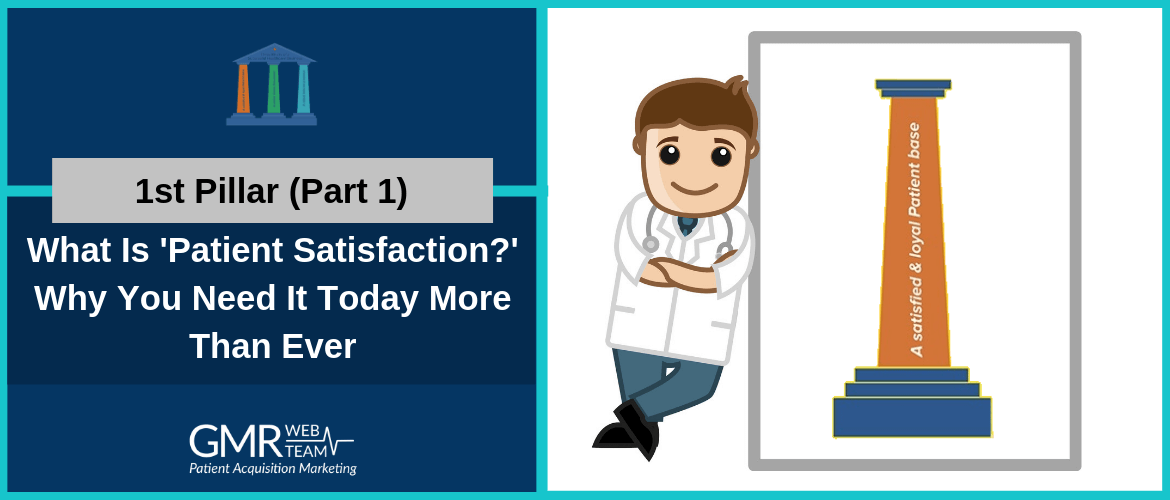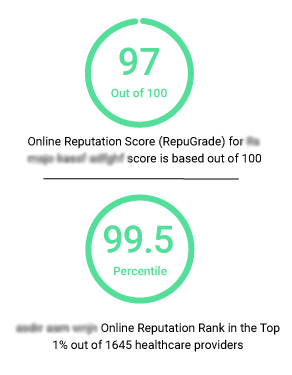1st Pillar (Part 1): What Is 'Patient Satisfaction?' Why You Need It Today More Than Ever

Providing an exceptional level of satisfaction to your patients is something that determines the fate of your healthcare business today. That's because in this digital age, the key success metrics of your hospital, your practice, each of your providers, and even your nursing staffs are linked to the kind of satisfaction they all are collectively able to provide to your patients. Patient satisfaction being an important and a common indicator to measure the quality of healthcare, holds a major part of the decision to be made about hospital reimbursements. Whether you like it or not, 30% of the decision is derived from how well hospitals score on the Hospital Consumer Assessment of Healthcare Providers and Systems (HCAHPS) survey, a measure of customer (or patient) satisfaction. The widespread access to the internet, social media, review websites, and other such platforms have only raised the competition. This has led you to consider your patients more as consumers, and has established patient satisfaction at the center of your healthcare business's financial health.
Importance of Patient Satisfaction in Present Times
CMS (Centers for Medicare & Medicaid Services) and HCAHPS project team have been making continuous moves to produce credible, useful, and practical data about patients' perspectives of care for an objective and meaningful comparisons of hospitals or healthcare clinics. This has created a fierce competition among hospitals and healthcare clinics to gain good scores on the patient satisfaction front because, as mentioned earlier, a major part of the decision about hospital reimbursement is derived from how well hospitals score on this front. Which means your hospital's financial health is dependent on this. A low HCAHPS score signifies a larger number of dissatisfied patients, how unhappy or dissatisfied patients can prove to be a bad deal for your healthcare business is detailed below:
- Unhappy Patients Equals Low Ratings: Unhappy patients tend to be more vocal about sharing their bad experience with the world. They go on rating you badly and writing negative reviews about you on different online platforms. Bad reviews can affect even the most highly reputed providers with a robust internet presence. Unhappy patients boil down to a lower ratings.
- Low Ratings Equals Low Patient Visits: Patients check, on an average, 12 different sources before picking up a provider, says Google. A major part of their decision to pick you is decided by your overall ratings and reviews online and social media comments. You can imagine what kind of content your prospective patients are going to find if your existing patients are leaving your office unhappy and dissatisfied. The result of low ratings is low patient visits to your practice.
- Low Patient Visits Equals to Bad Financial Health: It's not difficult to understand that lower patient visits to your clinic means you're bound to lose out on revenue. However, what you may not have understood yet is this: “it is estimated that, in the US, the loss of a patient due to dissatisfaction can result in the loss of over $200,000 in income over the lifetime of the practice”. Now you should be able to clearly see why patient satisfaction is given so much importance these days!
That's why you need to focus on factors that can help you improve patient satisfaction. But what are those factors? Read below:
- Communication with executives, nurses, and doctors all in contact with patients on the phone, face-to-face, or even when interacting on social media.
- Responsiveness as they travel through your hospital or clinic asking for procedures and medicines. It also includes your sites response when they navigate through it or scheduling an appointment.
- Pain management through medicines, therapy, or psychologists. As it doesn't matter how well you treat if you can't ease their suffering.
- Cleanliness in terms of sanitation, access to fresh food and water, clean clothes, and a pleasant smell. Also a quiet environment is appreciated.
- Discharge instructions written carefully that address all discharge medications and their usage instructions such as dosages, frequencies, and side effects.
- Overall ratings for everything from communication, responsiveness, cleanliness, diagnosis, treatment, and discharge instructions represent a complete picture of the quality of care.
Of all these, doctors' and nurses' communication skills and their responsiveness have become a key hospital performance measure, according to a 2016 white paper by Deloitte.
Patient Satisfaction Is Good for Providers and Patients
Patient satisfaction affects clinical outcomes, patient retention, and medical malpractice claims. It affects the timely, efficient, and patient-centered delivery of quality health care.
A higher level of patient satisfaction helps your healthcare business in many ways apart from increasing patient acquisition. Here are a few:
- Improved clinical outcomes: When your patients trust in you and your service, it results in improved clinical outcomes for your patients, which increases patient referrals for you.
- Helps Build a Loyal Patient Base: Needless to say that when your patients are satisfied with your service, they'll keep visiting you every time they will need to see a doctor. Also important to patient satisfaction is retaining your unhappy patients. Healthcare online reputation management does that very well and helps convert your unhappy patients into your most loyal promoters. That's what any healthcare practice strives to achieve!
- Reduces the risk of medical malpractice claims: Studies suggest that an improved doctor-patient communication, and satisfaction results in a lower risk of medical malpractice claims or lawsuits. The more satisfied your patients are, the less the chance they will think of suing you for any alleged negligence.
Final Thoughts!
Place patient satisfaction at the core of your healthcare marketing strategy, as it has been placed by the authorities like the CMS and HCAHPS while determining how you should be reimbursed for your services. Only then you'll be able to get into the mindset of your patients as well as the authorities to create a win-win situation for all; your patients, who'll get a great service; your healthcare business, which will benefit by an improved ROI; and the regulatory authorities, who will not have to hesitate placing you on top of the patient satisfaction report. Last time, we introduced the 3 Pillars of Healthcare Marketing Success to you. This was a more detailed discussion on the 1st pillar which is 'a satisfied & loyal patient base'. In the next blog in this series, we'll continue our detailed discussion on the 1st pillar itself. Stay tuned, till then!
Comments are closed


